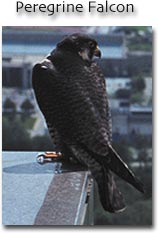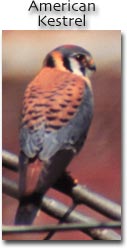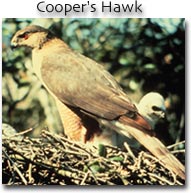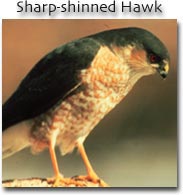Main Content
Article
Identifying Peregrine Falcons
Five different species of falcon have been observed in Indiana:
- Gyrfalcons and prairie falcons have only rarely been seen.
- Merlins migrate through the state annually, and rarely breed in the northern part of the state.
- The other two species, the peregrine falcon and the American kestrel are more common and both nest in the state.
Falcons are built for speed, having streamlined bodies, pointed wings and long tails.
If you see a hawk-like small to medium sized bird in your backyard, it is probably a Cooper’s hawk or a sharp-shinned hawk. These birds are commonly found in backyard areas that boast healthy songbird populations. Both perch and nest in trees and move swiftly through trees and bushes.
The Cooper’s hawk is similar in size (crow size) and coloring to the peregrine falcon, but a peregrine falcon would not be in a backyard looking for food. Peregrines use a high perch from which to swoop down on birds flying below. A peregrine’s dive reaches 200 mph and they hunt in open, tree-less areas. They are most likely to be seen in downtown areas of Indiana's largest cities, along Lake Michigan, and along rivers and lakes during migration.
In addition, the Cooper’s hawk and sharp-shinned hawk do not have the distinctive “moustache” that the falcons have on their face. When perched, their tails are much longer than their short wings, which are specially adapted for making quick turns while chasing other birds between trees.
Peregrine Falcon

The Peregrine falcon is 15-20 inches tall with a 38-44 inch wingspan, about the size of a crow.
Adults have a distinctive dark hood and "side burns" running down from the eyes. The back and wings are blue-gray, the throat white, and the breast is white to buff with gray barring.
Immatures are dark brown in color with a buffy feather edging. The hood and moustache are less distinctive than in the adult. The breast is brown with heavy streaking.
Peregrine falcons feed on medium-sized birds including pigeons, doves, blue jays, and starlings.
Many peregrine falcons in the Midwest, including the chicks, are equipped with identification bands on their legs. One leg band is purple or silver, while the other is black and green, black and red, or black and blue, with a unique letter/number combination.
American Kestrel

Photo by Academy of Natural
Sciences Philadelphia ©Vireo
The American kestrel is a blue jay sized bird, 12 inches long with a 20-24.5 inch wingspan. Kestrels have a short neck and a large head. The head has a black and white pattern along the cheeks with a dark vertical line (also called a moustache) running down from each eye. Two spots on the back of the head may appear to be eyes when viewed from behind. There is a patch of rust on the top of the head. American kestrels have a reddish-brown back and tail. Males have blue-gray wings, while females have brown wings.
American kestrels feed on large insects, small rodents (bats, mice), and birds.
Kestrels, Indiana’s smallest falcon, are most often found in agricultural areas, and grasslands. They are cavity nesters and it is not unusual to find them nesting in the eaves of houses, barns, and other buildings. American kestrels will also readily accept nest boxes placed in open areas.
Cooper's Hawk

Photo by Academy of Natural
Sciences Philadelphia ©Vireo
The Cooper's hawk is a slim-bodied hawk with short, rounded wings. About the size of a peregrine falcon, this hawk is 14-21 inches long and has a 27 - 36 inch wingspan.
The adult Cooper's hawk has a dark blue-gray back and wings. The top of this hawk's head is dark, while the throat and breast have rust-colored barring.
The tail is usually rounded with four or more blackish bars, while the eyes are yellow to deep red. An immature Cooper’s hawk has a brown back and brown wings and a white breast with brown streaking.
Cooper’s hawks eat birds and small mammals.
Sharp-shinned Hawk

Photo by Academy of Natural
Sciences Philadelphia ©Vireo
The sharp-shinned hawk is a slim-bodied hawk with short, rounded wings. The hawk is similar in size to an American kestrel. It is 10-14 inches long and has a 20-27 inch wingspan.
The sharp-shinned hawk looks a lot like a Cooper’s hawk, only smaller. An adult “sharpie” has a grey nape, with the grey continuing uninterrupted from the top of the head down to its back.The long legs are thinner than a drinking straw. In flight, their wings appear more pushed forward, and their heads proportionally smaller, than the more common Cooper’s hawk. Sharp-shinned hawks are rare breeders in Indiana and are found most commonly during spring and fall migration, and during winter.
The sharp-shinned hawk feeds mostly on small birds. Both the Cooper's and sharp-shinned hawk favor wooded and brushy areas.
